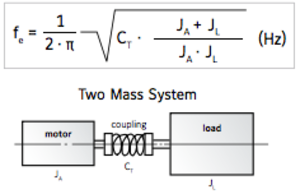SIZING AND SELECTION BELLOWS COUPLINGS BX
Systems
| TKN | Rated torque of coupling (Nm) |
| TAS | Peak torque (Nm) |
| JL | Moment of inertia of the load (load + drive line components + half of coupling) (kgm2) |
| JA | Drive inertia (rotor of motor + drive line components + half of coupling) (kgm2) |
| CT | Torsional stiffness of coupling (Nm/rad) |
| fe | Resonant frequency of the two mass system (Hz) |
| fer | Excitation frequency of the drive (Hz) |
| φ | Angle of twist (degree) |
|
|


According to torque
Couplings are normally sized for the highest torque to be regularly transmitted. The peak torque of the application should not exceed the rated torque of the coupling. The following calculation provides an approximation of the minimum required coupling size, and allows for the maximum rated speed and misalignment to exist in the application.

According to acceleration torque
A more detailed calculation takes acceleration and the driving and driven moments of inertia into account. A strong inertia ratio diminishes the effect of the load factor in the sizing calculation.

According to resonant frequency
The torsional natural frequency of the coupling must be significantly higher or lower than that of the equipment. For the mechanical substitution model the two mass system applies.
In practice the following applies: fe ≥ 2⋅ fer

According to torsional deflection
To calculate transmission error as a result of torsional stress:
